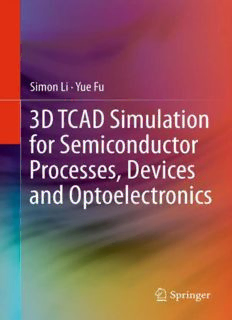Table Of Content3D TCAD Simulation for Semiconductor
Processes, Devices and Optoelectronics
Simon Li Yue Fu
l
3D TCAD Simulation for
Semiconductor Processes,
Devices and Optoelectronics
SimonLi YueFu
CrosslightSoftware,Inc. CrosslightSoftware,Inc.
Burnaby,BC,Canada Burnaby,BC,Canada
[email protected] [email protected]
ISBN978-1-4614-0480-4 e-ISBN978-1-4614-0481-1
DOI10.1007/978-1-4614-0481-1
SpringerNewYorkDordrechtHeidelbergLondon
LibraryofCongressControlNumber:2011934485
#SpringerScience+BusinessMedia,LLC2012
Allrightsreserved.Thisworkmaynotbetranslatedorcopiedinwholeorinpartwithoutthewritten
permissionof the publisher (SpringerScience+Business Media, LLC, 233 SpringStreet, New York,
NY10013,USA),exceptforbriefexcerptsinconnectionwithreviewsorscholarlyanalysis.Usein
connectionwithanyformofinformationstorageandretrieval,electronicadaptation,computersoftware,
orbysimilarordissimilarmethodologynowknownorhereafterdevelopedisforbidden.
Theuseinthispublicationoftradenames,trademarks,servicemarks,andsimilarterms,evenifthey
arenotidentifiedassuch,isnottobetakenasanexpressionofopinionastowhetherornottheyare
subjecttoproprietaryrights.
Printedonacid-freepaper
SpringerispartofSpringerScience+BusinessMedia(www.springer.com)
Preface
3DIsforRealLife
Wearelivingina3Dworld.Everythingweseeisin3D.Seeingisbelieving.
3DIsTechnologyTrend
The movies we watch have just turned 3D. Now, even the TVs we watch, the
electronic games we play are turning 3D. The same trend is happening to semi-
conductortechnologymodeling.
3DIsforTeachingandLearning
Traditionally semiconductor devices are taught with their cross sections and
students may never get a chance to see the real 3D picture. It is time to explore a
wholenewworldofsemiconductordevicesintheiroriginal3Dform.
APictureIsWorthaThousandWords
With explosive amount of information available in the information age, a new
generation of students demands more efficient way of learning than reading long
paragraphs of texts. Whenever possible, this book uses 3D illustrations to explain
theideasinsemiconductorprocessinganddevicemodeling.
WhatIs3DTCAD?
The semiconductor transistor is the foundation of modern electronics technology
andisundoubtedlyoneofthegreatinnovationsofthetwentiethcentury.Technology
Computer Aided Design (TCAD) refers to numerical modeling of semiconductor
technology process and device characteristics using software tools. Some of the
earlieriterationsofthesetoolsweredevelopedatStanfordUniversityinthe1980’s
andwerein1Dor2Dduetolimitationsincomputerspeedandmemory.Thisbook
extendstheseconceptstoanewdimension.
v
vi Preface
3D TCAD is now made possible because of advances in computer hardware.
3DTCADgivesusanunprecedentedexperienceindevicedesignandnewinsights
intotheirbehavior.Forthefirsttime,weareabletoviewthedeviceastheyactually
existratherthanusing2Dcrosssections.
Why3DTCAD?
Semiconductordevicesareallin3Daswepointedout.Manydeviceshavestrong
3Deffectswhichconventional2Dsimulationcannotprovidetheaccuracyrequired
inTCADprojects.
HowtoSetup3DTCAD?
Thismightbetheveryfirstbookthatdealsexclusivelywith3DTCADsimulation.
The book will be focused on how to set up a 3D TCAD simulation, from mask
layout all the way to electrical/optical device simulation. We offer plenty of 3D
exampleswithstepbystepguidance,makingthebookausefulreferenceforthose
who wish to set up their first 3D simulation using any TCAD tools with 3D
capability.
ThisbookisarrangedintenChapters.Thefirstchapterprovidesanoverviewof
semiconductorindustryandTCADusage.Thesecondandthirdchapteraredevoted
to giving advanced user an overview of the physical models used in both process
anddevicesimulation.Thefourthchapterpreparesthereaderwithbasicknowledge
of 3D TCAD. It will bridge the gap between layout mask and simulation. Topics
likehow toset up3D TCAD,thefile structure andan overview ofthesimulation
toolsareincluded.UseofGPUaccelerationin3DTCADisalsoexplained.
DeviceexamplesstartfromChap.5andaredividedintoseveralcategories:P-N
junction diodes, MOSFET and CMOS technology, power devices, interconnect,
CMOSimagesensorandLaserdiodes.Theseexamplescovermostofthepopular
devicesinusetodayandprovideusefultechnologyandphysicsinsights.
WhoIsThisBookFor?
Senior undergraduate students and graduate students, working professionals and
engineers,professorswhowishtofindateachingreferencebookandotherswhoare
interestedinlearningaboutsemiconductordevicesorsimulations.
3DIsforRealLife
Wearelivingina3Dworld.Everythingweseeisin3D.Seeingisbelieving.
Acknowledgments
We are especially grateful to our colleague, Mr. Michel Lestrade, who spent
countlesshoursreviewingandeditingofthisbook.
Preface vii
Special thanks to Dr. George Xiao from Crosslight, who has made significant
contributions to Chap. 9. We would also like to express our deep appreciation to
Professor Maggie Xia from the University of British Columbia, Professor John
ShenfromUniversityofCentralFlorida,Mr.GangXiefromUniversityofToronto
and Mr. Yuanwei Dong from the University of British Columbia for their careful
reviewsandsuggestions.
Burnaby,BC,Canada SimonLi
YueFu
Contents
1 SemiconductorIndustryandTCAD ..................................... 1
1.1 TheSemiconductorIndustry.......................................... 1
1.1.1 TypesofSemiconductorCompanies......................... 3
1.1.2 SemiconductorEngineeringGroupsinaTypicalIDM...... 4
1.2 ATypicalAnalog/PowerTechnologyDevelopmentFlow........... 5
1.2.1 PlanningStage ................................................ 6
1.2.2 DeviceDesignStage.......................................... 7
1.2.3 FabricationandTestStage.................................... 7
1.2.4 ReliabilityandQualificationStage........................... 8
1.3 AboutTechnologyComputerAidedDesign(TCAD)................ 9
1.3.1 DifferenceBetweenICCADandTCAD..................... 9
1.3.2 SemiconductorProcessSimulator............................ 11
1.3.3 SemiconductorDeviceSimulator............................. 11
1.3.4 Why3DTCAD?.............................................. 13
1.3.5 StackedPlanesMethodvs.TraditionalBulkMethod
for3DTCAD ................................................. 13
1.3.6 Quasi-3Dvs.Full-3DinProcessSimulation................. 16
2 AdvancedTheoryofTCADProcessSimulation........................ 19
2.1 DiffusionModelinTCAD............................................ 19
2.1.1 Vacancies ..................................................... 19
2.1.2 Interstitials .................................................... 20
2.1.3 ActiveImpurities.............................................. 21
2.1.4 InactiveImpurities............................................ 22
2.1.5 NeutralImpurities............................................. 23
2.1.6 Si-GeInter-diffusion.......................................... 23
2.2 StressModels ......................................................... 24
2.2.1 GoverningEquations.......................................... 24
2.2.2 IntrinsicStress ................................................ 25
2.3 Oxidation.............................................................. 27
2.3.1 OxideasaNewtonianFluid.................................. 27
ix
Description:Technology computer-aided design, or TCAD, is critical to today’s semiconductor technology and anybody working in this industry needs to know something about TCAD. This book is about how to use computer software to manufacture and test virtually semiconductor devices in 3D. It brings to life the t

